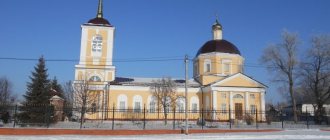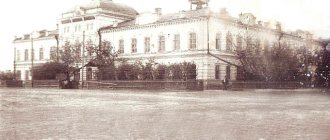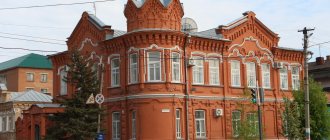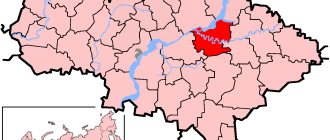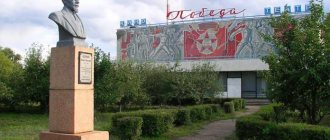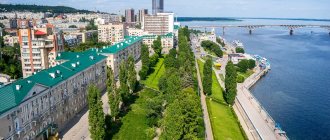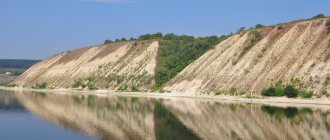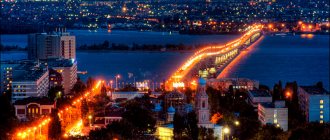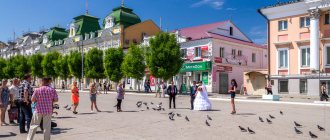Balakovo is one of the largest cities in the Saratov region, second only to the regional capital and Engels. It is located partly on the left bank of the Volga, partly on an island. It is separated from the regional center by 176 kilometers in a straight line, this is not the longest distance for the Volga regions.
The territory of the city is 75 square kilometers. Communication with surrounding cities is ensured by the operation of a bus station, railway station, and river port.
About the city of Balakovo
The townspeople are proud that Balakovo is the only city in which 5 high-impact all-Union construction projects took place, during which the most important production facilities were created, on which the economy of both the settlement and the region is based. They also contribute to the regional budget.
Balakovo also became the only city in which three types of power plants operate simultaneously. The Saratov hydroelectric power station was built in the period from 1956 to 1971; part of the coastal areas, villages, churches was flooded to ensure the fulfillment of the tasks of the electric power industry.
Balakovo Nuclear Power Plant is a modern nuclear power plant that supplies energy to many neighboring regions.
The history of the settlement is connected with the Cossacks, free people who were the first to begin to develop the territory of the Saratov province. Thus, the first mention of the town in chronicles dates back to 1738, then Balakovo was a Cossack meadow possession and was called Balakov Yurt.
Perhaps the first settlement with this name arose during the time of Ivan the Terrible; it served to protect the waterway from robbers. The official history of Russian urban planning dates the founding of the future city to 1762.
It was then that Empress Catherine II, in her manifesto, obliged the Old Believers to move to the banks of the Volga and cultivate wild virgin lands. At first they settled in the area between the Greater and Lesser Irgiz rivers. In this area, settlers received about 76 thousand hectares of fertile land for use.
The transformation of a village into a city dates back to 1911. More than 18 thousand people lived here then. The economy of the settlement was built on the trade in bread and rafting of timber. Before the revolution, there were 7 schools, 6 churches, an iron foundry and a grain exchange.
The founder of the plant, Yakov Vasilyevich Mamin, and his colleague Fedor Abramovich Blinov left a mark not only in the history of Balakovo, but throughout Russia, by creating the country's first caterpillar tractor, wheeled self-propelled vehicle and diesel engine.
For a long time, Balakovo was part of the Samara province, and only in 1936 it became part of the Saratov region.
Numerous industrial enterprises make a significant contribution to the city’s economy, among which the recently built one occupies a special place. Among the sister cities of Balakovo one can name the capital of Azerbaijan Baku and Cherepovets.
The building of the trading house of A. A. Schmidt
Finally, we definitely need to see the building of the trading house of A. A. Schmidt, which is one of the architectural symbols of the city. It is located on the corner of 20 Let VLKSM and Chernyshevsky (formerly Samara) streets. Construction - 1912, obvious Art Nouveau, one of the best examples of this style in Balakovo. The latter fact allows some authors to claim that F. Shekhtel took part in the design of the building, who was visiting Balakovo at that time to supervise the construction of the Trinity Church.
A. A. Schmidt was one of the largest traders in the Samara and Saratov provinces; he specialized in the sale of agricultural implements, textiles, haberdashery, and weapons. A list of goods presented in his Balakovo store has been preserved - among them: revolvers, hunting rifles, gunpowder, Singer sewing machines, Aitner bicycles, Badovsky mowers, Continental tires, Gargoyle gasoline and oil, etc. Internal the layout of the building, according to contemporaries, was reminiscent of the St. Petersburg “Passage” - the second floor was an open shopping gallery. The interiors of that time, unfortunately, have not been preserved, but the external appearance of the building has remained unchanged: the figured balcony, bay windows with turrets, the unusual “curvilinear” window of the northern facade and sculptures placed in niches are especially beautiful here: the characters of the sculptures were selected to emphasize the purpose of the building, - this is the god of trade Mercury, the goddess of hunting and fertility Diana, as well as the sower and the reaper.
Coat of arms of Balakovo
The coat of arms of the locality has a long and glorious history. It was officially approved in 2000, but carries the symbolism of antiquity.
In the official description you can read that a boat with a golden sheaf floating in the blue field of the shield symbolizes the historical significance of the city as a large grain pier on the Volga.
The rising Sun framed in red indicates the Saratov Hydroelectric Power Station and the Balakovo Nuclear Power Plant, thanks to which the city acquired the status of the largest energy center on the Volga.
In the free part there is the coat of arms of the Saratov region, like all regional centers, it depicts three intertwined silver sterlets in an azure field.
Famous people of Balakovo
Many famous people were natives of Balakovo. The already mentioned Y. Mamin and F. Blinov influenced the history of technology in Russia. But there were also more famous Balakovites.
Among them, the first place is rightfully occupied by the legendary Vasily Ivanovich Chapaev, who lived in the city for a long time. Now there is a museum in his house. The famous performer Denis Maidanov and Sergei Chelobanov, a widely known composer and singer in the 90s of the twentieth century, influenced the domestic stage.
It is impossible not to pay attention to Valery Dmitrievich Gordeev, the most famous motorcycle racer of the Soviet era, who won many domestic and foreign awards. The city is also famous for its famous nuclear scientists and industrialists.
The building of the Alexandrov trading house
In pre-revolutionary Balakovo, in the Art Nouveau style, not only estates were built, but also trading houses, of which there were also plenty here, which is no wonder - the village (and since 1911 the city) was a trading place. To get acquainted with the pre-revolutionary trading houses of Balakov, let's walk a little along Zaovrazhnaya Street and turn left: onto Sovetskaya Street (formerly Nikolskaya). Three blocks later, at the intersection with 20 Let VLKSM Street (formerly Mariinskaya), our first goal.
Building number 59 is a former trading house. Some sources note that this is the former trading house of Alexandrov, but Alexandrov is indicated as the last owner, and the builder of this expressive building with an airy corner bay window topped with an elegant turret is named merchant A. A. Kuznetsov. Balakovo local historian Yu. Kargin, having studied archival documents, proved that there was a mistake with Kuznetsov and that this house was built by the same Alexandrov, who died in 1912. At the time of the owner’s death, the building housed a wine and gastronomic store, as well as clothing, shoe and hat stores. In the house, which has been well restored, which is, generally speaking, a rarity for Balakov, an ancient cast-iron staircase has been preserved.
Education and culture Balakovo
The city is responsible for the cultural development of not only its residents, but also the population of the region. Now there are about 30 secondary schools successfully operating in the city. Professional education of young people is provided by the Balakovo Industrial and Transport College named after. N. V. Gribanova, medical college, polytechnic college, college of arts.
Future employees of State Energy and Nuclear Power Plants can receive high-quality education at the Balakovo Engineering and Technology Institute, a branch of the MEPhI Nuclear Institute. There are also branches of RANEPA and the well-known Saratov Law Institute.
The newspapers “Essence” and “Stubborn Facts” inform citizens about life in Balakovo. Balakovo also has its own television. The local history museum is located in the mansion of V.V. Golovanov, here you can get a complete picture of the history and culture of the area.
The city has a drama theater and a Young Spectator Theater, and has its own philharmonic society, on whose stage many famous artists have performed. The Balakovo Art Gallery presents the viewer with an interesting collection of icons of ancient writing and paintings by artists of the 19th and 20th centuries.
Streets and sights of Balakovo
The city grew according to a general plan, typical for all regional centers created during the reign of Empress Catherine II. It is distinguished not by the ring structure characteristic of former fortresses, but by a regular layout with designated quarters.
Now geographically the city is divided into 3 parts. These are the island (located only on the island of Zhilgorodok, the Old Town and the small village of Dzerzhinsky), the canal (microdistricts 1 to 4, which also includes the village of Sazanley) and the central, located on the shore and built up with modern houses (from microdistricts 5 to 11 and the village of Raduzhny ).
The island is separated from the city by a canal; transport communication previously took place via an inconvenient sluice bridge. This significantly hampered transport communication during peak hours. More than 80 thousand people live on the island, and the long-awaited opening of the new bridge in 2015 significantly changed the quality of life of the townspeople.
It was planned back in the USSR period and was built over 6 years, with the last months at an accelerated pace. It was opened in the year of the 70th anniversary of the victory in the Great Patriotic War and was named the Victory Bridge. The monument to the Builders of the Five All-Union Komsomol Shock Construction Projects will be of interest to fans of Soviet-era monuments. It is located in the old part of the city. The flat fountain with 48 colored jets attracts everyone's attention.
Lenin and Torch of Socialism streets are considered prestigious streets in Zhilgorodok and the old center; ancient merchant mansions have been preserved here. Among the main attractions of Balakovo, the Chapaev House-Museum, the Lebedev Drama Theater, and the estate of the merchant Maltsev are most often mentioned. The estate is an elegant one-story mansion, decorated with a balustrade, stucco molding and columns.
The architecture of the old part of the city was largely created by the works of famous architects H.V. Meyer and F.O. Shekhtel, who built the most beautiful temple in the city, the Church of the Life-Giving Trinity and the mansion of P.I. Maltsev. You can take a walk in the ancient park, which has been called the esplanade since pre-revolutionary times.
Photos of Balakovo
Balakovo: Attractions Photos Weather Map Hotels
Countries of the worldRussiaCitiesBalakovo
1
This collection contains 53 photographs of Balakovo, its views, houses and attractions, which were taken by local residents, tourists and photographers. In order to view a photo album of a specific attraction, you need to go to the appropriate section on the object’s page. All photos of Russian cities and attractions are presented in high quality, we hope that this will help you get to know them better.
VKontakte facebook twitter
Photos of other Russian cities Photos of Moscow Photos of St. Petersburg Photos of Sochi Photos of Tula Photos of Yaroslavl Photos of Vladimir Photos of Voronezh Photos of Yekaterinburg Photos of Ryazan Photos of Tver Photos of Sevastopol Photos of Dmitrov Photos of Rostov the Great Photos of Ivanovo Photos of Orel Photos of Nakhodka Photos of Belgorod Photos of Bryansk Photos of Volgograd Photos of Kazan Photos of Kaluga Photos Krasnodar Photo Lipetsk Photo Nizhny Novgorod Photo Penza Photo Samara Photo Saratov Photo Smolensk Photo Tambov Photo Chelyabinsk Photo Anapa Photo Kolomna Photo Yuzhno-Sakhalinsk Photo Vladivostok Photo Grozny Photo Izhevsk Photo Kostroma Photo Kursk Photo Omsk Photo Perm Photo Rostov-on-Don Photo Ufa Photo Cheboksary Photo Chita Photo Kerch Photo Pushkin Photo Sergiev Posad Photo Murom Photo Yeisk Photo Abakan Photo Saransk Photo Dolgoprudny Photo Balashikha Photo Irkutsk Photo Kirov Photo Novosibirsk Photo Orenburg Photo Podolsk Photo Ulyanovsk Photo Essentuki Photo Magadan Photo Alushta Photo Mytishchi Photo Krasnoyarsk Photo Togliatti Photo Khabarovsk Photo Myshkin Photo Kaliningrad Photo Rybinsk Photo Stavropol Photo Suzdal Photo Tomsk Photo Tyumen Photo Pyatigorsk Photo Ukhta Photo Astrakhan Photo Blagoveshchensk Photo Murmansk Photo Novorossiysk Photo Pskov Photo Ulan-Ude Photo Gelendzhik Photo Uglich Photo Pitkyaranta Photo Arkhangelsk Photo Barnaul Photo Vologda Photo Yoshkar-Ola Photo Kemerovo Photo Kurgan Photo Magnitogorsk Photo Nalchik Photo Surgut Photo Taganrog Photo Yakutsk Photo Simferopol Photo Balakovo Photo Svetlogorsk Photo Ordzhonikidze Photo Zheleznovodsk Photo Engels Photo Komsomolsk-on-Amur Photo Armavir Photo Vladikavkaz Photo Makhachkala Photo Norilsk Photo Tuapse Photo Yalta Photo Torzhok Photo Ples Photo Alexandrov Photo Volgodonsk Photo Angarsk Photo Bratsk Photo Naberezhnye Chelny Photo Novokuznetsk Photo Syzran Photo Cherepovets Photo Sudak Photo Veliky Novgorod Photo Kislovodsk Photo Kalyazin Photo Mineralnye Vody Photo Kovrov Photo Belokurikha Photo Pereslavl-Zalessky Photo Sortavala Photo Derbent Photo Petrozavodsk Photo Syktyvkar Photo Feodosia Photo Novocherkassk Photo Vyborg Photo Kozelsk Photo Elista Photo Balaklava Photo Foros Photo Nizhnevartovsk Photo Petropavlovsk-Kamchatsky Photo Pechora Photo Salekhard Photo Tobolsk Photo Valdai Photo Yuryev-Polsky Photo Nizhny Tagil Photo Severodvinsk Photo Anadyr Photo Zadonsk Photo Khanty-Mansiysk Photo Priozersk Photo Vorkuta Photo Temryuk Photo Dzerzhinsk Photo Gatchina Photo Kronstadt Photo Yelabuga Photo Veliky Ustyug Photo Maykop Photo Staraya Russa Photo Miass Photo Khasavyurt Photo Shlisselburg Photo Alupka Photo Bakhchisarai Photo Peterhof Photo Palekh Photo Velikiye Luki Photo Baltiysk Photo Igarka Photo Nevyansk Photo Nerekhta Photo Kidekshi Photo Verkhoturye Photo Shchelkino Photo Dalmatovo Photo Ostashkov Photo Chernyakhovsk Photo Gorokhovets Photo Ussuriysk Photo Sterlitam aka Photo of Zelenogradsk Photo of Neman Photo of Sovetsk Photo of Polessk Photo of Severomorsk Photo of Roslavl
Balakovo
Description Attractions Photo Weather Map Hotels
See also: Photos of Nikolaev, Sights of Morocco, Cities of Turkmenistan, Zimbabwe, Klaipeda, Yasothon, Cossack farm Galushkovka, Keukenhof Flower Park
Neighborhoods of Balakovo
When visiting Balakovo, you should definitely plan excursions around its surroundings. Summer holidays will be incomplete without visiting the numerous lakes surrounding the city, thanks to which it is also called the “Volga Venice”.
On Pustynny Island you can have a good rest the whole summer by pitching tents and fishing. This is exactly how many Balakovo families relax.
A visit to Balakovo will be interesting both from the point of view of understanding the history of the region and from the point of view of exploring the sights.
See also: Districts of the Saratov region.
